-

新人教版高中英语选修2Unit 5 Using langauge-Listening教学设计
The theme of this section is to learn how to make emergency calls. Students should learn how to make emergency calls not only in China, but also in foreign countries in English, so that they can be prepared for future situations outside the home.The emergency telephone number is a vital hotline, which should be the most clear, rapid and effective communication with the acute operator.This section helps students to understand the emergency calls in some countries and the precautions for making emergency calls. Through the study of this section, students can accumulate common expressions and sentence patterns in this context. 1.Help students accumulate emergency telephone numbers in different countries and learn more about first aid2.Guide the students to understand the contents and instructions of the telephone, grasp the characteristics of the emergency telephone and the requirements of the emergency telephone.3.Guide students to understand the first aid instructions of the operators.4.Enable Ss to make simulated emergency calls with their partners in the language they have learned1. Instruct students to grasp the key information and important details of the dialogue.2. Instruct students to conduct a similar talk on the relevant topic.Step1:Look and discuss:Match the pictures below to the medical emergencies, and then discuss the questions in groups.

新人教版高中英语选修2Unit 4 Reading and thinking教学设计
【词汇精讲】highlight n.最好或最精彩的部分 vt.突出;强调;使醒目One of the highlights of the trip was seeing the Taj Mahal.这次旅行的亮点之一是参观泰姬陵。Your resume should highlight your skills and achievements.你的简历应该突出你的技能和成就。The report highlights the major problems facing society today.报告强调了当今社会所面临的主要问题。I’ve highlighted the important passages in yellow.我用黄色标出了重要段落。7.Edmonton is freezing cold in winter,with daily temperatures averaging -10 ℃.埃德蒙顿冬季寒冷,日平均气温为-10°C。【词汇精讲】freezing adj.极冷的;冰冻的Leave a basin of water outside in freezing weather.在冰冻的天气里,放一盆水在室外。It’s freezing cold outside so wear a warm coat.外面超冷的,所以穿一个暖和一点的外套吧。8.It was not until 9:30 a.m.that they finally reached the capital of Ontario,Toronto.直到上午9时30分,他们才终于到达多伦多的首府安大略省。【句式剖析】本句是一个强调句,强调的是句子的时间状语until 9:30。含有not...until...的句子的强调句为It is not until...that...,that后面的句子要用肯定形式。It was not until then that I suddenly realized nobody was happier than I was.直到那时我才突然意识到没有人比我更幸福了。

新人教版高中英语选修2Unit 2 Learning about Language教学设计
The activity theme of this section is to design various activities around the key words in the first text. Therefore, the activities require students to pay attention to the spelling of words. On the other hand, let students grasp the meaning of words more accurately through sentences and short texts. This kind of teaching design also helps to improve the ability of using English thinking.1. Cultivating students' ability to use word formation to induce and memorize vocabulary, and the ability to use lexical chunks to express meaning.2. Guide the students to think independently and use the correct form of words to complete sentences3. Cultivate students' habit of using lexical chunks to express language completely, guide students to draw words in sentences quickly, pay attention to word collocation, so as to accumulate more authentic expressions4. Instruct students to create sentences with the chunks.1. Enable students to use the language points in the real situation or specific contexts flexibly and appropriately.2. Guiding the Ss to use unit topic words and the sentence patterns in a richer context.Step1: Think of a word that best fits each definition.1. to remember sth2.to accept, admit, or recognize sth or the truth/existence of sth3. the process of changing sth or yourself to suit a new situation4 .to make sb feel less worried or unhappy5. a strong desire to achieve sth

新人教版高中英语选修2Unit 2 Reading and thinking教学设计
Her tutor told her to acknowledge __________ other people had said if she cited their ideas, and advised her _______(read) lots of information in order to form __________wise opinion of her own.Now halfway __________ her exchange year, Xie Lei felt much more at home in the UK. She said __________ (engage) in British culture had helped and that she had been__________ (involve) in social activities. She also said while learning about business, she was acting as a cultural messenger __________(build) a bridge between the two countries. keys:Xie Lei, a 19yearold Chinese student, said goodbye to her family and friends in China and boarded (board) a plane for London six months ago in order to get a business qualification. She was ambitious(ambition) to set up a business after graduation. It was the first time that she had left (leave) home.At first, Xie Lei had to adapt to life in a different country. She chose to live with a host family, who can help with her adaptation (adapt) to the new culture. When she missed home, she felt comforted (comfort) to have a second family. Also Xie Lei had to satisfy academic requirements. Her tutor told her to acknowledge what other people had said if she cited their ideas, and advised her to read lots of information in order to form a wise opinion of her own.Now halfway through her exchange year, Xie Lei felt much more at home in the UK. She said engaging (engage) in British culture had helped and that she had been involved (involve) in social activities. She also said while learning about business, she was acting as a cultural messenger building a bridge between the two countries.

新人教版高中英语选修2Unit 2 Reading for writing教学设计
The theme of this section is to express people's views on studying abroad. With the continuous development of Chinese economic construction, especially the general improvement of people's living standards, the number of Chinese students studying abroad at their own expense is on the rise. Many students and parents turn their attention to the world and regard studying abroad as an effective way to improve their quality, broaden their horizons and master the world's advanced scientific knowledge, which is very important for the fever of going abroad. Studying abroad is also an important decision made by a family for their children. Therefore, it is of great social significance to discuss this issue. The theme of this section is the column discussion in the newspaper: the advantages and disadvantages of studying abroad. The discourse is about two parents' contribution letters on this issue. They respectively express their own positions. One thinks that the disadvantages outweigh the advantages, and the other thinks that the advantages outweigh the disadvantages. The two parents' arguments are well founded and logical. It is worth noting that the two authors do not express their views on studying abroad from an individual point of view, but from a national or even global point of view. These two articles have the characteristics of both letters and argumentative essays1.Guide the students to read these two articles, and understand the author's point of view and argument ideas2.Help the students to summarize the structure and writing methods of argumentative writing, and guides students to correctly understand the advantages and disadvantages of studying abroad3.Cultivate students' ability to analyze problems objectively, comprehensively and deeply

新人教版高中英语选修2Unit 2 Using langauge-Listening教学设计
? B: Absolutely! Getting involved with Chinese cultural activities there definitely helped a lot. I got to practice my Chinese on a daily basis, and I could learn how native Chinese speakers spoke.? A: What do you feel is your biggest achievement?? B: Learning Chinese characters! I have learnt about 1,500 so far. When I first started, I didn't think it was even going to be possible to learn so many, but now I find that I can read signs, menus, and even some easy newspaper articles.? A: What are you most keen on?? B: I've really become keen on learning more about the Chinese culture, in particular Chinese calligraphy. As I have learnt Chinese characters, I have developed a great appreciation for their meaning. I want to explore Chinese characters by learning how to write them in a more beautiful way. ? A: Finally, what do you want to say to anyone interested in learning Chinese?? I have really become keen on learning more about the Chinese culture, in particular Chinese Calligraphy. As I have learnt Chinese character, I have developed a great appreciation for their meaning. I want to explore Chinese characters by learning how to write them in a more beautiful way.? A: Finally, what do you want to say to anyone interested in learning Chinese?? B: I'd say, give it a shot! While some aspects may be difficult, it is quite rewarding and you will be happy that you tried.? A: Thanks for your time. ? B:You're welcome.

新人教版高中英语选修2Unit 3 Using langauge-Listening教学设计
1. How is Hunan cuisine somewhat different from Sichuan cuisine?The heat in Sichuan cuisine comes from chilies and Sichuan peppercorns. Human cuisine is often hotter and the heat comes from just chilies.2.What are the reasons why Hunan people like spicy food?Because they are a bold people. But many Chinese people think that hot food helps them overcome the effects of rainy or wet weather.3.Why do so many people love steamed fish head covered with chilies?People love it because the meat is quite tender and there are very few small bones.4.Why does Tingting recommend bridge tofu instead of dry pot duck with golden buns?Because bridge tofu has a lighter taste.5 .Why is red braised pork the most famous dish?Because Chairman Mao was from Hunan, and this was his favorite food.Step 5: Instruct students to make a short presentation to the class about your choice. Use the example and useful phrases below to help them.? In groups of three, discuss what types of restaurant you would like to take a foreign visitor to, and why. Then take turns role-playing taking your foreign guest to the restaurant you have chosen. One of you should act as the foreign guest, one as the Chinese host, and one as the waiter or waitress. You may start like this:? EXAMPLE? A: I really love spicy food, so what dish would you recommend?? B: I suggest Mapo tofu.? A: Really ? what's that?

新人教版高中英语选修2Unit 4 Reading for writing教学设计
假定你是英国的Jack,打算来中国旅行,请你给你的中国笔友李华写一封信,要点如下:1.你的旅行计划:北京→泰山→杭州;2.征求建议并询问他是否愿意充当你的导游。注意:1.词数80左右(开头和结尾已给出,不计入总词数);2.可以适当增加细节,以使行文连贯。参考词汇:故宫 the Forbidden City;泰山 Mount TaiDear Li Hua,I'm glad to tell you that 'm going to visit China.First,I am planning to visit Beijing,the capitalof China,where I am looking forward to enjoying the Great Wall,the Forbidden City and somebeautiful parks.Then I intend to go to visit Mount Tai in Shandong Province.I've heard that it is one ofthe most famous mountains in China and I can't wait to enjoy the amazing sunrise there.After that,I amalso going to Hangzhou.It is said that it is a beautiful modern city with breathtaking natural sights,among which the West Lake is a well- known tourist attraction.What do you think of my travel plan? Will you act as my guide? Hope to hear from you soon.
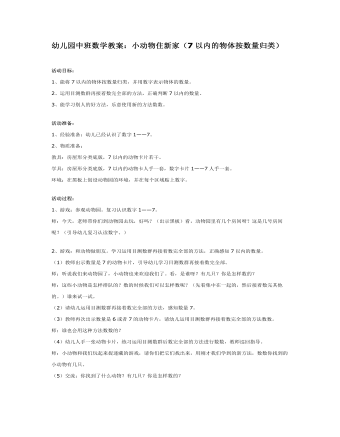
幼儿园中班数学教案:小动物住新家
2、运用目测数群再接着数完全部的方法,正确判断7以内的数量。 3、能学习别人的好方法,乐意使用新的方法数数。活动准备: 1、经验准备:幼儿已经认识了数字1——7。 2、物质准备: 教具:房屋形分类底版,7以内的动物卡片若干。 学具:房屋形分类底版,7以内的动物卡人手一套,数字卡片1——7人手一套。 环境:在黑板上创设动物园的环境,并在每个区域贴上数字。 活动过程: 1、游戏:参观动物园。复习认识数字1——7。 师:今天,老师带你们到动物园去玩,好吗?(出示黑板)看,动物园里有几个房间呀?这是几号房间呢?(引导幼儿复习认读数字。) 2、游戏:和动物做朋友。学习运用目测数群再接着数完全部的方法,正确感知7以内的数量。

中班数学教案:身上的数字
2、激发对自我的认同及喜爱之情。材料准备:1、记录卡;录像、“我”(外部、内部);我的数字档案卡人手一张;活动过程: 一、理解数的实际意义:1、这几天你们找过体内和体外的数字了吗?现在请你们记录下来。2、幼儿用记录卡进行记录,老师观察指导。3、交流记录卡内容,老师有意识地将不变和可变的数字分别记录在两张卡上。4、说说小朋友身上哪些数字是一样的?哪些数字是不一样的?为什么?
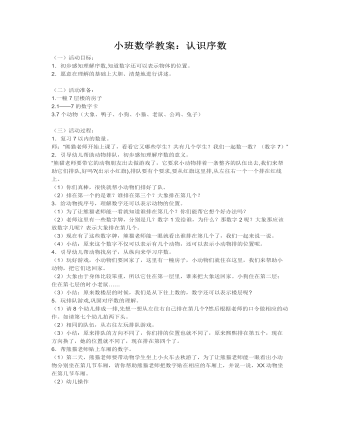
小班数学教案:认识序数
(二)活动准备: 1.一幢7层楼的房子 2.1——7的数字卡 3.7个动物(大象、鸭子、小狗、小猫、老鼠、公鸡、兔子) (三)活动过程: 1.复习7以内的数量。 师:“熊猫老师开始上课了,看看它又哪些学生?共有几个学生?我们一起数一数?(数字7)” 2.引导幼儿帮助动物排队,初步感知理解序数的意义。 “熊猫老师要带它的动物朋友出去做游戏了,它要求小动物排着一条整齐的队伍出去,我们来帮助它们排队,好吗?(出示小红旗),排队要有个要求,要从红旗这里排,从左往右一个一个排在红线上。 (1)你们真棒,很快就帮小动物们排好了队。 (2)排在第一个的是谁?谁排在第三个?大象排在第几个?
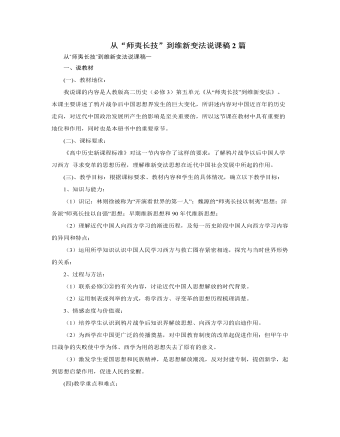
人教版高中历史必修3从“师夷长技”到维新变法说课稿2篇
(一)、教材地位:我说课的内容是人教版高二历史(必修3)第五单元《从“师夷长技”到维新变法》。本课主要讲述了鸦片战争后中国思想界发生的巨大变化,所讲述内容对中国近百年的历史走向,对近代中国政治发展所产生的影响是至关重要的,所以这节课在教材中具有重要的地位和作用,同时也是本册书中的重要章节。(二)、课标要求:《高中历史新课程标准》对这一节内容作了这样的要求:了解鸦片战争以后中国人学习西方 寻求变革的思想历程,理解维新变法思想在近代中国社会发展中所起的作用。(三)、教学目标:根据课标要求、教材内容和学生的具体情况,确立以下教学目标:1、知识与能力:(1)识记:林则徐被称为“开演看世界的第一人”;魏源的“师夷长技以制夷”思想;洋务派“师夷长技以自强”思想;早期维新思想和90年代维新思想;
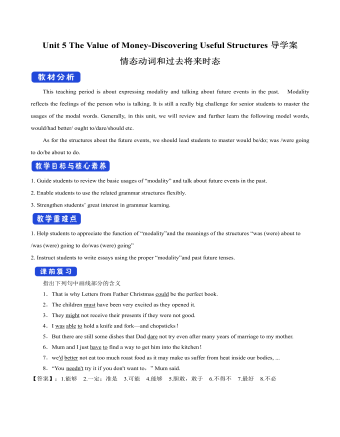
新人教版高中英语必修3Unit 5 The Value of Money-Discovering Useful Structures导学案
4.They were going to find someone to take part in their bet when they saw Henry walking on the street outside.[归纳]1.过去将来时的基本构成和用法过去将来时由“would+动词原形”构成,主要表示从过去某一时间来看将要发生的动作(尤其用于宾语从句中),还可以表示过去的动作习惯或倾向。Jeff knew he would be tired the next day.He promised that he would not open the letter until 2 o'clock.She said that she wouldn't do that again.2.表示过去将来时的其他表达法(1)was/were going to+动词原形:该结构有两个主要用法,一是表示过去的打算,二是表示在过去看来有迹象表明将要发生某事。I thought it was going to rain.(2)was/were to+动词原形:主要表示过去按计划或安排要做的事情。She said she was to get married next month.(3)was/were about to+动词原形:表示在过去看来即将要发生的动作,由于本身已含有“即将”的意味,所以不再与表示具体的将来时间状语连用。I was about to go to bed when the phone rang.(4)was/were+现在分词:表示在过去看来即将发生的动作,通常可用于该结构中的动词是come,go,leave,arrive,begin,start,stop,close,open,die,join,borrow,buy等瞬间动词。Jack said he was leaving tomorrow.
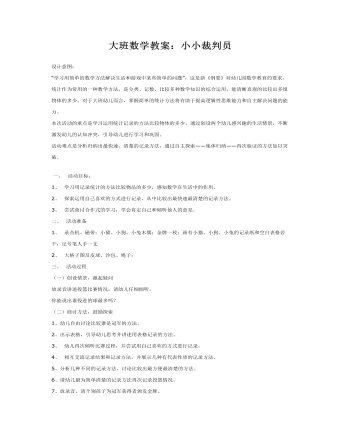
大班数学教案:小小裁判员
本次活动的重点是学习运用统计记录的方法比较物体的多少,通过创设两个幼儿感兴趣的生活情景,不断激发幼儿的认知冲突,引导幼儿进行学习和巩固。活动难点是分析归纳出最快速、清楚的记录方法,通过自主探索——集体归纳——再次验证的方法加以突破。 一、 活动目标:1、 学习用记录统计的方法比较物品的多少,感知数学在生活中的作用。2、 探索运用自己喜欢的方式进行记录,从中比较出最快速最清楚的记录方法。3、 尝试商讨合作式的学习,学会肯定自己和倾听他人的意见。二、 活动准备1、 录音机、磁带;小猫、小狗、小兔木偶;金牌一枚;画有小猫、小狗、小兔的记录纸和空白表格若干,记号笔人手一支2、 大格子图及皮球、沙包、绳子;三、 活动过程(一)创设情景,激起疑问放录音讲述投篮比赛情况,请幼儿仔细倾听。你能说出谁投进的球最多吗?
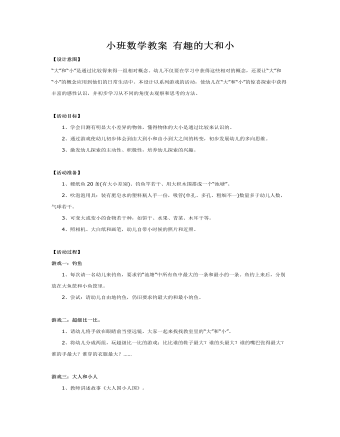
小班数学教案 有趣的大和小
【活动目标】1、学会目测有明显大小差异的物体,懂得物体的大小是通过比较来认识的。2、通过游戏使幼儿初步体会到由大到小和由小到大之间的转变,初步发展幼儿的多向思维。3、激发幼儿探索的主动性、积极性,培养幼儿探索的兴趣。 【活动准备】1、硬纸鱼20条(有大小差别)、钓鱼竿若干、用大积木围搭成一个“池塘”。2、吹泡泡用具:装有肥皂水的塑料瓶人手一份,吸管(单孔、多孔、粗细不一)数量多于幼儿人数,气球若干。3、可变大或变小的食物若干种,如饼干、水果、青菜、木耳干等。4、照相机、大白纸和画笔,幼儿自带小时候的照片和近照。
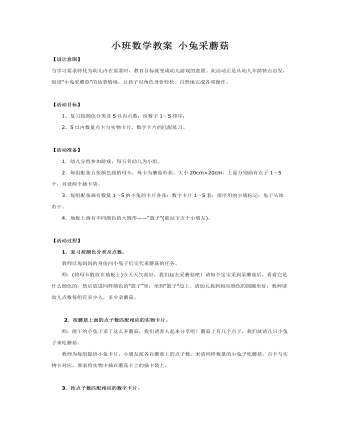
小班数学教案 小兔采蘑菇
【活动目标】1、复习按颜色分类及5以内点数;给数字1~5排序;2、5以内数量点卡与实物卡片、数字卡片的匹配练习。 【活动准备】1.幼儿分组参加游戏,每五名幼儿为小组。2.每组配备五张颜色致的母卡,母卡为蘑菇形状,大小20cm×20cm,上面分别画有点子1~5个,另设两个插卡袋。3.每组配备画有数量1~5的小兔的卡片各张;数字卡片1~5套;排序用的小旗标记;兔子头饰若干。4.地板上画有不同颜色的大圆形——“篮子”(能站下五个小朋友)。
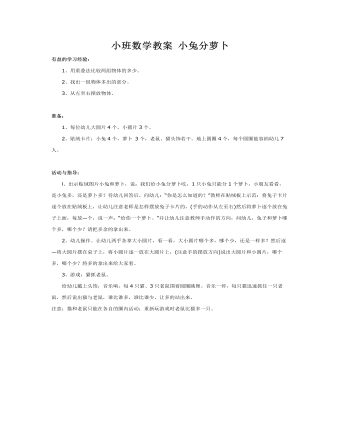
小班数学教案 小兔分萝卜
2、找出一组物体多出的部分。3、从左至右摆放物体。 准备:1、每位幼儿大圆片4个,小圆片3个。2、贴绒卡片:小兔4个,萝卜 3个,老鼠、猫头饰若干。地上圆圈4个,每个圆圈能容纳幼儿7人。 活动与指导:l、出示贴绒图片小兔和萝卜,说:我们给小兔分萝卜吃,1只小兔只能分1个萝卜,小朋友看看,是小兔多,还是萝卜多?待幼儿回答后,问幼儿:“你是怎么知道的?”教师在贴绒板上示范:将兔子卡片逐个放在贴绒板上,让幼儿注意老师是怎样摆放兔子卡片的,(手的动作从左至右)然后将萝卜逐个放在兔子上面,每放—个,说一声:“给你一个萝卜。”并让幼儿注意教师手动作的方向,问幼儿,兔子和萝卜哪个多,哪个少?请把多余的拿出来。

小班数学教案:蝴蝶找花 (认识颜色)
2、教幼儿学习把相同颜色的不同物体放在一起。 3、激发幼儿参与活动的兴趣,培养幼儿讲述操作过程的习惯。 活动准备: 1、红、黄、绿色的小房子(纸盒做的)各一个,幼儿每人一篮(3—6片)红、黄、绿色雪花片。 2、红、黄、绿色花一朵,红、黄、绿色蝴蝶卡片各一个。 活动过程: 1、蝴蝶找花(把相同颜色的物体放在一起)。 教师出示红、黄、绿色花卡片和红、黄、绿色蝴蝶卡片各一个,讲述小故事,“花园里住着三只美丽的蝴蝶,一只是红色的(舞动红蝴蝶),一只是黄色的(舞动黄蝴蝶),还有一只是绿色的(舞动绿蝴蝶)。它们天天在花园里唱歌、跳舞、做游戏,非常快乐。有一天,三只蝴蝶正在花园里玩‘捉迷藏’的游戏,忽然‘哗啦拉’下起雨来,三只蝴蝶想在花姐姐的叶子下面避雨,花姐姐说:‘和我颜色一样的蝴蝶请进来吧!’谁愿意帮助三只蝴蝶找到相同颜色的花?” 2、游戏“蝴蝶找花”

小班数学教案:蝴蝶找花 (认识颜色) (2)
2、巩固按物体的数量匹配相应的点卡。 3、在教师的引导下,理解活动操作过程,能正确地进行操作。 活动准备: 水果实物(苹果1个、橘子2个、梨子3个),单独的动物图片(每种动物数量分别是1、2、3),1—3的点卡,盘子3个,大分类箩筐1个。 活动过程: 一、妈妈买的水果。 1、教师(出示一篮水果):这是妈妈刚才买回来的水果,请你帮助妈妈一起来整理水果好吗? 2、师幼将水果拿出来放在桌子上说一说:有哪些水果? 3、启发幼儿思考:我们怎样整理它们呢?引导幼儿把一样的水果放在一个盘子
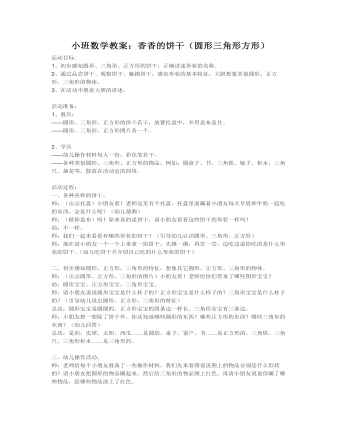
小班数学教案:香香的饼干(圆形三角形方形)
2、通过品尝饼干、观察饼干、触摸饼干,感知形状的基本特征,大胆想象其他圆形、正方形、三角形的物体。 3、在活动中愿意大胆的讲述。 活动准备: 1、教具: ——圆形、三角形、正方形的饼干若干,放置托盘中,并用盖布盖住。 ——圆形、三角形、正方形图片各一个。 2、学具 ——幼儿操作材料每人一份,彩色笔若干。 ——各种类似圆形、三角形、正方形的物品,例如:圆盘子、书、三角铁、镜子、积木、三角尺、插花等,散放在活动室的四周。

